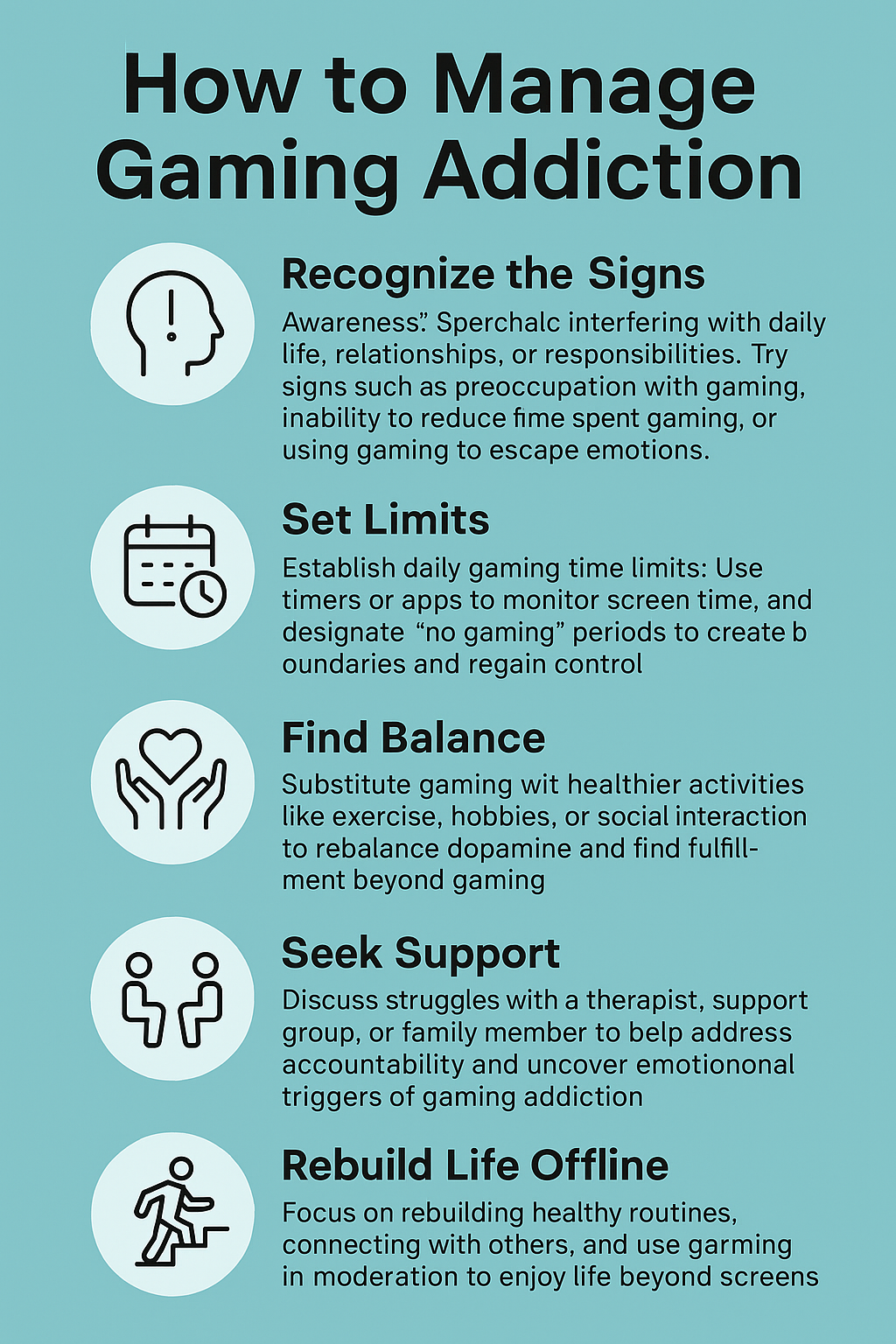
Many gamers find joy and excitement in the digital world. However, sometimes, the thrill becomes a challenge when gaming affects daily life. Gaming addiction is more common than many realize, and taking control can be an adventure in balancing fun with a healthy lifestyle.
When gaming takes over more than leisure time, it can interfere with relationships, work, or school. The routines may feel hard to break, and the digital escape seems nearly irresistible. Fortunately, there are practical strategies to help manage gaming addiction while making room for other interests and healthier routines.
This guide provides clear advice and a straightforward plan to help you adjust your gaming habits without feeling deprived. You can regain balance and control by identifying triggers, setting limits, and substituting old patterns with positive alternatives.
Step 1: Recognize and Define Your Gaming Habits
The first step in solving any problem is to understand it. When it comes to gaming addiction, it is essential to understand what your habit looks like and how it affects your daily life. Begin by recording how much time you spend gaming and what feelings surface during those sessions.
Questions to Ask Yourself
- How many hours do I spend playing on a typical day or week?
- At what time of day do I feel most drawn to gaming?
- Do I use gaming to escape stress or discomfort?
- How does gaming impact my sleep, work, and personal relationships?
Understanding Your Triggers
- Notice moments when you feel compelled to pick up your controller.
- Observe if certain games cause stronger emotional responses.
- Identify the environments that encourage longer gaming sessions.
Reflecting on these points helps you map your behavior, laying a foundation for manageable, lasting change.
Step 2: Establish Clear Boundaries and Goals
It is essential to set clear limits and objectives rather than eliminate gaming completely, and plan designated times for play and times to step away. These limits can help transform chaotic habits into a structured routine.
How to Set Your Gaming Limits
- Decide on the maximum hours you will spend gaming each day or week.
- Schedule regular breaks and designate areas in your home where gaming is not allowed.
- Plan specific times to focus on work, study, or relaxation.
- Consider apps that track screen time to help you stick to your limits.
Creating Achievable Goals
- Set small, incremental targets, such as reducing gaming time by 10 minutes per day.
- Write down what you hope to achieve with extra free time, whether learning a new skill, exercising, or connecting with friends.
- Keep your expectations realistic. Suddenly, drastic cuts may feel overwhelming and hard to sustain.
With specific and reasonable goals, gradually adjusting your routine becomes less daunting, allowing you to maintain leisure without sacrificing balance.
Step 3: Introduce Alternative Healthy Habits
Substituting gaming time with other enjoyable activities can ease the transition. Choose alternatives that match your interests and offer relaxation or mental stimulation. The goal is not to stop having fun, but to add some variety to how you spend your free time.
Ideas for New Activities
- Pick up a creative hobby such as drawing, writing, or learning a musical instrument.
- Engage in physical activities like short walks, home workouts, or stretching routines.
- Challenge your mind with puzzles, books, or board games.
- Experiment with learning a new language or even try cooking new recipes.
Building Replacement Habits
- Start small by committing 15-20 minutes a day to your new hobby.
- Gradually increase the time invested in these activities as they become a natural part of your day.
- Celebrate small victories to keep yourself motivated and encouraged.
Though changes might not feel immediate, steady effort can integrate these alternatives into your routine, replacing old patterns with fresh pursuits.
Step 4: Manage Distractions and Environmental Triggers
Your surroundings can sometimes prompt you to game longer than intended. Adjusting your environment can help interrupt the habit cycle and support your new routine.
Rethinking Your Environment
- Create a dedicated gaming space you can avoid during work or relaxation.
- Keep areas meant for rest or study free of any gaming paraphernalia.
- Reduce visual cues such as posters or memorabilia that remind you of gaming.
- Organize your room so your work or study zone feels more welcoming than your gaming corner.
Handling Digital Distractions
- Turn off game notifications during work or study periods.
- Use apps to block gaming sites when you need to focus on other tasks.
- Occasionally, schedule a digital detox day with minimal screen time.
Changing your surroundings helps break the automatic impulse to play, creating a balanced environment that supports diverse activities.
Step 5: Plan and Structure Your Day with Alternative Activities
A structured day can prevent unattended hours that lead to excessive gaming. Organize your schedule with dedicated time blocks for work, hobbies, and relaxation to ensure that gaming remains one of many enjoyable activities.
Managing Your Daily Schedule
- Prepare a daily agenda with fixed meals, work, exercise, and leisure times.
- Incorporate short breaks between tasks to recharge without switching to gaming.
- If you choose to game, set aside specific hours so that it does not dominate your day.
Example Schedule
- Morning: Begin with a healthy breakfast, followed by exercise or meditation.
- Midday: Dedicate time to work or study, followed by a break to explore a hobby.
- Evening: Enjoy leisure time, including a limited gaming session, balanced with dinner, family time, or reading.
A well-planned schedule ensures that gaming is only one small part of your day, allowing you to explore other fulfilling activities and reducing dependence on digital play.
Step 6: Create an Environment That Supports Positive Change
Your physical space significantly influences your habits. A tidy and attractive setting reinforces your goals and encourages new activities while discouraging old patterns.
Ways to Reorganize Your Space
- Set aside areas dedicated to work or creative projects, free from gaming equipment.
- Arrange your gaming setup to be inviting but not overpowering in your living space.
- Add elements like plants or soft lighting to foster relaxation and focus.
- Declutter frequently to maintain a calm environment that minimizes stress and distractions.
Using Physical Reminders
- Keep books, art supplies, or exercise gear visible as constant reminders of other interests.
- Consider moving devices or canceling nonessential subscriptions to reduce temptations.
An environment that reflects your goals makes it easier to avoid impulsive gaming sessions. When your space actively supports broader interests, it naturally guides you toward healthier choices.
Step 7: Stay Consistent While Remaining Flexible
Maintaining consistency is very important, but staying adaptable is equally essential. Changing a long-held habit is challenging, and there will be both good days and setbacks. The key is to keep progressing and learn from any slip-ups.
Tips for Long-Term Consistency
- Create a routine that fits naturally into your everyday life.
- Keep a journal to record your gaming time and note any patterns or improvements.
- Reward yourself when you stick to your limits, and don’t be too hard on yourself when things don’t go perfectly.
- Be open to adjusting your targets as you learn more about what works best for you.
Even if you occasionally fall back into old habits, use those moments as opportunities to reflect and refine your approach. Small, consistent efforts eventually lead to a more balanced lifestyle.
Common Questions and Troubleshooting
What if I need gaming to relax?
It is perfectly acceptable to game in moderation. The key is setting limits, so gaming does not overwhelm other areas of your life. Schedule a fixed time for gaming and fill the rest of your day with varied activities.
How can I manage the urge to play when stressed or bored?
- Create a list of alternative relaxing activities, such as listening to music or taking a brief walk.
- Practice mindfulness or quick relaxation techniques in moments of high stress.
- Talk to a friend or professional who can help you work through those feelings.
What if I slip and spend too many hours gaming?
Change does not happen overnight. If you find yourself gaming excessively, try to identify what triggered the relapse. Adjust your strategy and start again without harsh self-judgment.
How do I explain my new habits to friends or family?
Open communication is essential. Explain your goals and the reasons for setting limits to those close to you. Their understanding and support can make the transition easier and may encourage them to try new activities with you.
Final Thoughts and Next Steps
Managing gaming addiction is not about completely cutting out enjoyment but finding a healthier balance that leaves time for various interests and responsibilities. The process might initially feel challenging, but every minor adjustment brings you closer to a more controlled and fulfilling lifestyle.
Your Action Plan
- Begin by tracking your current gaming habits and pinpointing when and why you play.
- Set realistic limits on your gaming sessions and deliberately plan alternative activities for those times.
- Reorganize your space to support focus and diverse interests.
- Maintain a progress log, celebrate small victories, and learn from setbacks.
The adventure of managing gaming addiction is personal, and every step forward counts. Reflect on what small change you can commit to today. Taking that first step might be the extra push to create a balanced lifestyle that leaves plenty of room for fun, creativity, and meaningful growth.
Video: How To Break Free From Gaming Addiction!
